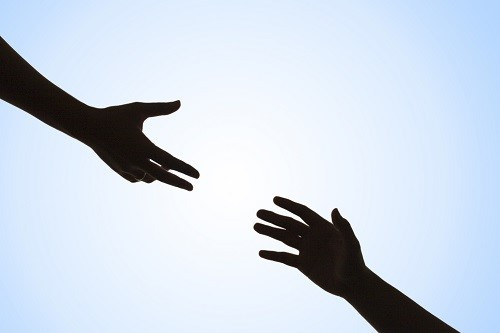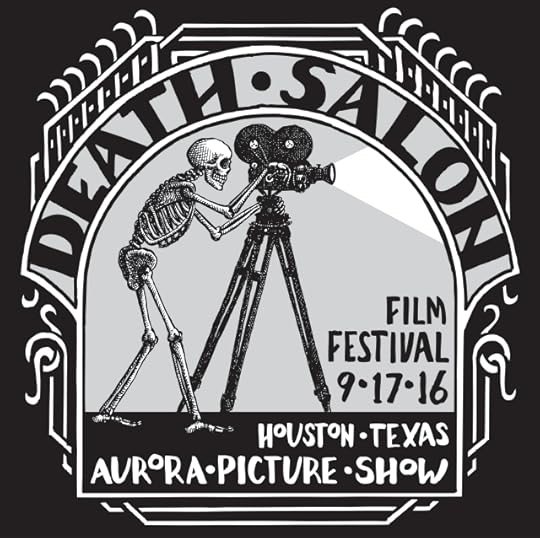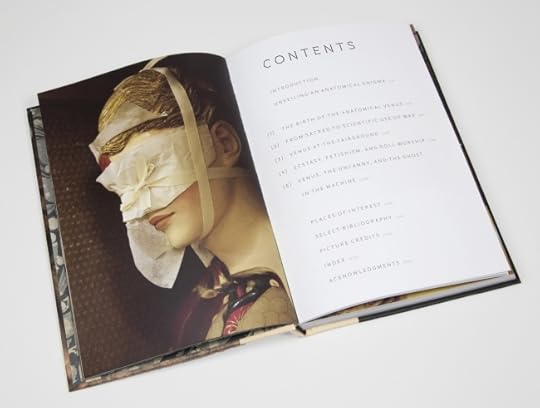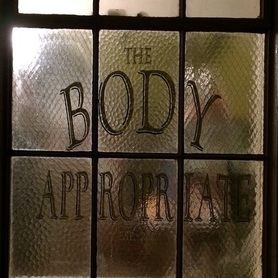Caitlin Doughty's Blog, page 35
June 30, 2016
June 28, 2016
KITSCHY DISASTER TOURISM
June 15, 2016
Death Positivity and Suicide
One of our readers wrote in to ask the following question:
A few of my friends have histories of suicidal ideation and attempts, and I worry that bringing up death preparedness could trigger them in some way. Obviously I don’t want to make my friends feel uncomfortable or anxious about something they have a hard relationship with (death), but is there a way to talk about death with them in a sensitive and meaningful way?
Another reader wrote in, speaking from the opposite side of the equation:
I’ve had history of suicidal thoughts and actions, and although I haven’t experienced these in awhile, every time I bring up death with my friends who know of my history, they get this terrified look on their faces, like “Oh God, is this happening again?” How do I explain that I now have a healthy, not weird at all attitude towards death and my impending mortality?
Does bringing up death preparedness push someone over the edge? If you talk about something, does it make it more likely to happen? Should you just not talk about death with certain people? First things first: if you, or someone you care about, is actively suicidal, do something about that NOW. Get help in your local community. Reach out to your friend. Don’t wait. If you’re not sure how to help or get help, click here for more resources.

Let me help you..
There’s a reason we need our whole death-positive movement: people are uncomfortable with death. In refusing to talk about death, we help sustain a culture that cannot tolerate grief – individually or collectively. Fear of grief, fear of loss, fear of being consumed by emotion bigger than us – these are the engines behind our death avoidance. Add into that discomfort the fear of someone we love killing themselves, it’s no wonder people get exceptionally twitchy around the combination of death education and prior suicidality.
Let’s take each of these writer’s questions in turn.
First, how do you bring up death-preparedness with those who might be triggered because of their past suicidal ideation?
I’m curious as to when, where, and why you’re having these conversations about death. Is it only with these people (because you know their history, and feel it’s an important topic), or is it a part of your life you share with most people? If death education and preparedness is something you share with most people, you might say – “I’ve been thinking and talking a lot about death preparedness, wills, advanced directives, what I want done with my body after I die. It’s important to me. And I’ve hesitated to talk about it with you. I don’t want to avoid death talk with you, but I also don’t want to bring up death in a weird way, or stumble around it because of your experience with being suicidal in the past. Would you be willing to talk about this together?”
(Important note: if your friend is currently suicidal, that’s your topic of conversation, not what to do about advanced directives.)
I’m a big fan of consent: if you’re unsure how something might impact another person, ask first. Don’t be afraid to address your concerns. Asking permission shows your respect for the other person’s heart, mind, and their control over when and where these topics are brought up. Bringing up the topic – addressing your concerns around suicidality, instead of managing those anxieties – helps your friend know that you’re okay with listening to difficult and often complex situations. You don’t have to do these conversations perfectly – you just need to show that you’re willing to go there.
Don’t let the suicidal elephant in the room be the thing you talk around. Address it. Make it clear that the topic of death-education can be tabled if your friend feels overwhelmed. If, and only if, you get a go ahead from your friend, then you’re welcome to talk about death education and preparedness. Move forward gently, and be willing to renegotiate and discuss how it’s going for both of you.
So what if you’re the one with the history of suicidal ideation, and bringing up death preparation makes people in freak out? How can you help them calm down and listen?
People are uncomfortable talking about death to begin with. People you love might have the added concern about your safety, no matter how long ago your suicidality was a relevant concern. If you’re in a place in your life where suicidal ideation is no longer present, then my answer is largely the same as above: address the weirdness rather than manage the weirdness. Be proactive when opening the topic. You might say something like, “death preparation is important to me. We’re all going to die, and having advanced directives, clear communication, and wills help everyone. I’ve noticed that when I talk about these things, you seem scared that I’m suicidal. Is that accurate?”
Asking directly lets you find out what your listener’s actual fears are, so that you can address them. Addressing those concerns is not the same as agreeing to not bring the topic up: “I recognize that my past history makes some people nervous about who I am now, and what I find important. I’m going to continue to care for myself and follow the things that interest me. If you have concerns about my safety, I’m happy to hear them. I also need you to trust that I have support systems in place, and the self care I need. My interest in death preparedness and education is not an indication of my relative safety or suicidality.”
You get to have interests. You get to have interests that make others uncomfortable. Death is uncomfortable for a lot of people, which is why we have such a messed up cultural emotional system in the first place. PLEASE talk about death. Please talk about death preparedness. And, do so with respect and acknowledgment for other peoples’ concerns about you. Just don’t let their concerns silence you. Don’t let their concerns stay underground and unexpressed and without dialogue – that’s always where things get messy.
(Important note, again: if you’re actively suicidal, that has to be addressed, and discussions about how to help people in your life accept your interests is not one bit relevant right now.)
In both situations, what we’re really talking about is creating an invitation to discuss uncomfortable things. Bringing both suicidality and death preparation out into the open, where we are no longer scared to talk about either issue, is important and powerful work. By addressing the weirdness and discomfort, we begin to make it safer to talk about these things. We bring everyone into the conversation, even and especially when they feel scared, overwhelmed, or nervous. And that’s good for both death-positive culture AND for decreasing the isolation of those who feel suicidal. Open, direct discussion is a sign of deep emotional intelligence, uncomfortable as it may be. Be brave. Be proactive. Go forth and discuss.
Megan Devine is the author of the audio book, Everything is Not Okay: practical tools to help you stay in your heart & not lose your mind. She’s a licensed clinical counselor, writer, widow, and sought after speaker. Her Writing Your Grief courses have connected grieving people all around the world, helping them speak the truth about their pain. Click the link to join the next session. You can find more of her writing, and sign up for her weekly letter, at www.refugeingrief.com.
June 6, 2016
ASK A MORTICIAN – Confronting Your Death
June 1, 2016
Calendar of Events – Summer 2016
Caitlin will be spending the summer hiding out in her underground DEATH BUNKER finishing her second book (due out in 2017). She will reemerge in late August like a beautiful, death’s-head moth, to participate in a writer’s festival in New Zealand. Details will be posted when available.
DEATH SALON

Art by Landis Blair
Save the Date! Our next Death Salon will take place in Houston on September 17, 2016 in partnership with the Aurora Picture Show! This will be our very first Death Salon Film Festival – submissions are currently open. Please visit the Death Salon website for details and be sure to sign up for the mailing list.
ORDER OF THE GOOD DEATH MEMBERS

Joanna Ebenstein will be at several events this summer, celebrating the release of her new book The Anatomical Venus . Anatomical Venus Book Launch at the Strand Rare Book Room on June 2nd in NY. Also, Anatomical Venus Book Release Party and Symposium on June 4th at Morbid Anatomy Museum.
Stephanie Smith will be performing with Dog Star 12: bitpanic, a night of works for networked electronic music performed by bitpanic and written by members of the ensemble on June 17th in Los Angeles.
Katrina Spade will be at the Funeral Consumers Alliance Conference on June 23-25 in Atlanta.
Dr. John Troyer will provide an introductory talk for 3rd Stage Dance Company’s performance of Mementos – The Journey on June June 24th & 25th in Bristol.
Annabel de Vetten will be hosting another Movie Taste-Along screening of Harold and Maude at The Electric Cinema as part of the Shock and Gore festival in July. Details TBA.
Vanessa Ruiz will be presenting at the Association of Medical Illustrators Conference on July 20-23 in Atlanta.
 Dr.Paul Koudounaris will be leading an after dark lantern tour at the Marvelous Dead and Darkness event on June 4th and 5th in Santa Ana.
Dr.Paul Koudounaris will be leading an after dark lantern tour at the Marvelous Dead and Darkness event on June 4th and 5th in Santa Ana.
He will also be leading a tour of LACMA exhibit Guillermo del Toro: At Home With Monsters focusing on the cultural history and significance of monsters and the monstrous on August 11th in Los Angeles.
Jim Doran will be teaching a diorama workshop using cigar boxes as part of The American Visionary Art Museum’s Diorama-rama on July 22nd in Baltimore.
DEATH SPACES RUN BY ORDER OF THE GOOD DEATH MEMBERS
The following institutions are run by members of the Order and offer a full calendar year of death positive events that are open to the public.
 The Body Appropriate, located in San Francisco, is run by Order Member Stephanie Stewart-Bailey. The Body Appropriate often features Sound Public Dissections, Visceral Cinema and more. Check the out the entire schedule here.
The Body Appropriate, located in San Francisco, is run by Order Member Stephanie Stewart-Bailey. The Body Appropriate often features Sound Public Dissections, Visceral Cinema and more. Check the out the entire schedule here.
 Join Barts Pathology Museum’s Technical Curator, Carla Valentine for an incredible array of events inside a stunning Victorian pathology museum in London. Taxidermy classes, potting workshops and an array of fascinating lectures await you. Check the official calendar of events here.
Join Barts Pathology Museum’s Technical Curator, Carla Valentine for an incredible array of events inside a stunning Victorian pathology museum in London. Taxidermy classes, potting workshops and an array of fascinating lectures await you. Check the official calendar of events here.
 Joanna Ebenstein’s incomparable Morbid Anatomy Museum in Brooklyn should be on every Deathling’s bucket list. In addition to visiting the museum you can catch any number of workshops, field trips, lectures and unique events. Coming up this season you can investigate the roles and powers of the dead in Western occult philosophy, learn about the connections between psychoanalysis, surrealism, mourning and sexuality or attend an evening of murder ballads, to name just a few. Visit their website for a full listing.
Joanna Ebenstein’s incomparable Morbid Anatomy Museum in Brooklyn should be on every Deathling’s bucket list. In addition to visiting the museum you can catch any number of workshops, field trips, lectures and unique events. Coming up this season you can investigate the roles and powers of the dead in Western occult philosophy, learn about the connections between psychoanalysis, surrealism, mourning and sexuality or attend an evening of murder ballads, to name just a few. Visit their website for a full listing.
OTHER DEATH POSITIVE EVENTS

Death, Art and Anatomy Conference is an interdisciplinary conference exploring the intersections between death, art and anatomy, by bringing together art historians, medical historians, and practicing artists. The conference takes place on June 3-6 in Winchester.
The Great American Casket Company is an immersive theatrical experience that explores what it means to have a good death. Multiple performances in New York throughout June.
Juneteenth at Historic Oakland Cemetery – Juneteenth is a nationally-recognized commemorative day celebrating the abolishment of slavery. Celebrate this historic day by touring the African American burial grounds, engaging in African American burial records and descendant research and various cultural activities for kids. June 11th in Atlanta.
3rd Stage Dance Company presents Mementos – The Journey. In the performance the dancers explore and understand the insight of how different cultures process losing those close to them, and how death features as a key chapter in one’s life. June 24th & 25th in Bristol. Order member, Dr. John Troyer will provide an introductory talk.
Huellas de las Memoria, shines a light on the drug-related deaths in Mexico, as well as Argentina, Honduras, El Salvador, and Guatemala. The art exhibit runs through June 25th in Mexico at Museo Casa de la Memoria Indomita.
Stephen Jenkinson will be in Los Angeles on July 29th for a Die Wise author talk and on the 30th for a full-day Die Wise event on Making Meaning on the Ending of Days.
The Centre for Death and Society Conference on Survival will take place on June 18 -19 at University of Bath, UK.
May 26, 2016
WHAT HAPPENED TO TITANIC’S DEAD?
May 8, 2016
CAN CORPSES TURN TO STONE?
April 28, 2016
ASK A MORTICIAN- Rapid Fire Death Questions
April 20, 2016
A Burial in West Africa
From 1985 to 1987 I was a Peace Corps volunteer in Togo, West Africa. I lived in a small village in the hot, dry, sub-Saharan north. My next-door neighbor was Adia, a 30-something man with a round face and a ready smile.
One morning, his maternal grandmother died quite unexpectedly. She was probably about 80, judging from the ages of her children and grandchildren, though most everyone you asked, including Adia, said she was over 100. It made me wonder about all the other folks who claimed to be 100.
Adia asked if I would drive him to the nearest town on my motorcycle to telephone his brothers. En route, we stopped at his grandmother’s house to check on things. Of all the close relations present, Adia was the senior male, and thus responsible for logistical details and organization. He lived for this stuff. Datebook in hand, he made a quick reconnaissance, as if he were the general checking in at headquarters.
The old woman lived in a small mud hut. The round, thatch-roofed dwelling was perched on a terrace below some cliffs, with a sweeping view of a boulder-strewn slope, and a valley below. Clouds lent depth to the sky. The air was still and warm.
Several older women bustled about, quietly cleaning and arranging the house and yard. The grandmother lay on her sleeping mat in the small, round room. A granary in the center kept the harvest safe from thieves and animals. The old woman was curled on her side, covered with a cloth, facing the wall. I expected to see her breath rise any moment.
We went to town, telephoned Adia’s brothers, then hurried back to his grandmother’s house. By now there were several dozen people milling around in the yard. Groups of old men were installed in quiet clusters in the shade. I couldn’t help wonder if they were dwelling more than usual on their own impending mortality.
Adia’s mother, “mama,” was there, and I went in to say hello. Her mother’s body had been moved to a mattress on a metal bed frame. Around it was a cluster of wailing women. Mama had swollen eyes and a very sad face. I gave her a hug, not knowing what else to do, and because it felt right, but I have no idea if it was appropriate.
Adia’s older brother had said he wouldn’t be able to come, but late in the afternoon his forest green sedan lumbered up to the gate. The faint sound of drums and wailing women echoed across the valley.
In such a hot climate, the body needed to be buried quickly. Near sunset, I put on my “village best” and went to watch the burial procession. The old woman had been wrapped in several layers of cloth, then lashed to four long wooden poles. Two young men carried her high above their heads, bouncing and swaying. Someone twirled a black parasol. The death of an old person is supposed to be cause for celebration, so the mood on the surface was festive. A throng of celebrants, well-plied with the local millet beer, was singing, dancing, whooping, and laughing.
The cemetery was a jumble of clay jars marking traditional graves, and several western-style, cement graves. I was told that only a few people knew how to dig a traditional grave–an egg-shaped hole about four feet deep, with a small access hole at the top.
As the crowd moved toward the grave, the carriers occasionally stopped and lowered the body to the ground. The crowd gathered around tightly, chanting loudly. I was told the body was being “hidden” from evil spirits.
We arrived at the grave site and the body was promenaded several times around the hole. The crowd, clumsy and aggressive with drink, pressed in closely. The bier was lowered to the ground. Amid much pushing and shoving by the crowd, the layers of cloth were removed one by one and handed to several women. The body was left in a thin white wrapping that gaped open in front. It was laced loosely, to prevent it falling off completely.
An old man stood in the hole, his head and shoulders above ground. The old woman’s body was lowered feet first into his arms and then into the hole. I’d never seen a dead body before, but unlike a white person, who I imagined would be a ghostly shade of pale blue, the old woman remained a healthy chocolate brown. Her body was limp. I was told she had been washed four times. Her nostrils were plugged with cotton from the kapok tree. Her eyes were closed, and her mouth hung open, her jaw slack. Her lips were the only bluish skin.
Once in the hole, she was curled in a fetal position, her hands under her head. A woman’s task is to prepare the evening meal after the family has worked all day, so she is buried facing the sunset. A man is buried facing the sunrise, as he must rise early each morning to work in his fields.
The old man climbed out of the hole and one of the old woman’s male relatives climbed in to make sure she was properly positioned. None of her children were allowed to be present, in this case because she had had twins. I don’t know if children were always barred from their parents’ burials, but in the case of twins, there were many special rules.
I was told that in the old days the body was covered with a layer of sticks. The opening was then closed with a round, flat rock. The dirt from the hole was piled on top, and an inverted clay jar was placed on the mound. If a young child in the family died, the grave could be opened, the sticks moved, and the child placed next to the elder, to be looked after and cared for. Our landlord said that several children were buried this way in his grandmother’s grave, but that this time-consuming and laborious process had become less common.
Once the old woman was positioned, two young men with short-handled hoes stepped forward and began scooping in dirt. As the hole filled, they tamped the dirt with sticks and rocks. Some quarreling began among the old men, and the crowd started to drift away. One of the old woman’s twenty-something granddaughters stood next to me, wide-eyed, and gasped, “My god, they’re juming up and down on my grandma!”
I went back to the funeral house and drank some millet beer under a crescent moon and a skyful of stars before heading home and leaving the crowd to its all-night vigil. After three days the family elders would meet to decide how and when the funeral ceremonies would take place.
In a farming economy, it makes sense to wait until the off season to hold the funeral, when people have more time. Grandma’s funeral was held months later. The family fed multitudes. There was all-night dancing to the beat of two-tone flutes and “talking” drums. The dancers shuffled in a circle for hours, sustained by kola nuts and millet beer, falling into a kind of trance. The next morning they returned to their homes, joyful, radiant, as if huge weights had been lifted from their shoulders. And perhaps they had.
Karen Story is a writer who lives in Kirkland, Washington, where she
volunteers with hospice and attends Death Cafes.
April 14, 2016
Morbid Minute – BOG BODY MURDER MYSTERY
Caitlin Doughty's Blog
- Caitlin Doughty's profile
- 8408 followers



